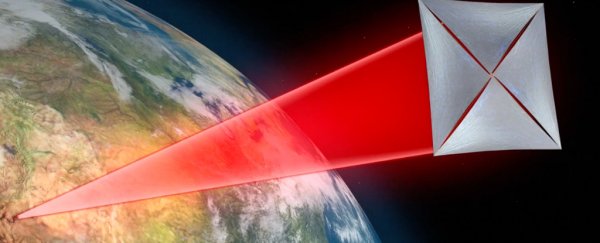One of the world's most brilliant minds has partnered up with one of the richest entrepreneurs, to announce an ambitious new project that could see human technology reach our closest star system, Alpha Centauri, within our lifetime.
With today's technology, it would take more than 30,000 years to make it to Alpha Centauri. But the new mission proposes using a fleet of tiny, stamp-sized 'nanocraft' that would be propelled by lasers to speeds of up to 20 percent the speed of light - meaning they would zoom past Pluto in just three days (!!), and could reach our neighbouring star just over 20 years after launch. The goal is to look for evidence of aliens outside our Solar System.
That's right, people, after centuries of dreaming about it, we're finally going to attempt to explore the stars - and we can't think of anyone better equipped to pull off the feat than physicist Stephen Hawking and space-loving Russian billionaire, Yuri Milner.
"For the first time in human history we can do more than just gaze at the stars," said Milner in a joint announcement with Hawking today in New York City. "We can actually reach them."
The project has been called 'Breakthrough Starshot' and Milner has now invested US$100 million into creating and launching the tiny nanocraft. Last year, Milner also invested millions into helping the search for extraterrestrial life using ground-based telescopes, but now he's taken things one step further and wants to send human technology out into the stars to track it down.
After pairing up with Hawking, Milner has also got a number of other big names involved, including Facebook creator, Mark Zuckerberg. The initiative will be led by Pete Worden, the former director of NASA's AMES Research Centre.
So how will Breakthrough Starshot work? Alpha Centauri is 4.37 light-years away, or 25 trillion miles (40.2 trillion km), and using our current, propellant-fuelled spacecraft, that journey would take us around 30,000 years - not exactly a feasible recon mission.
But Hawking and Milner have something different in mind for their star-explorer. Instead of burning up heavy rocket fuel to create thrust, the tiny spacecraft will be powered by light.
The spacecraft is called the 'Starchip' and is around the size of a postage stamp. Weighing around a gram, the Starchip will contain cameras, photon thrusters, power supply, navigation, and communication equipment, all squeezed down into a tiny package.
This spacecraft will be attached to a metre-sized 'Lightsail', which will be just a few atoms thick and weigh only a couple of grams. Just like Bill Nye's proposed spacecraft, this sail generates thrust by being 'pushed' by particles of light. But to speed things up a little bit, Milner and Hawking will use lasers to give their Starchip a boost.
Presenting their prototype at the launch today, Milner and Hawking calculate that blasting around 100 gigawatts of energy from ground-based lasers - a similar amount of power needed to lift the Space Shuttle off Earth - they'll be able to accelerate the tiny spacecraft to speeds of up to 161 million km/hour (100 million miles per hour).
At that speed, they could be at Alpha Centauri just over 20 years from launch. You can see the launch process in the video below:
The idea is to launch a whole fleet of these nanocrafts, so that they can spread out and make flybys of all the planets in our neighbouring star system, to see whether or not they might potentially be habitable.
Of course, all of this is theoretical for now. It's not the first time that scientists have proposed laser-powered spacecraft, and, on paper at least, the calculations all seem to add up. But Milner and Hawking haven't tested their spacecraft as yet, and they admit there's a long way to go.
"The Breakthrough concept is based on technology either already available or likely to be available in the near future," said Milner. "But as with any moonshot, there are major hurdles to be solved."
They're now asking for input from the international scientific community, as well as the general public, on how they can improve their plan - all the prototypes and information will stay open access throughout the mission.
Sure it's an ambitious move, but so was the Moon landing, and our first mission to Mars. And if anyone has the ability to pull it off, it's the people behind Breakthrough Starshot. We're pretty excited.
